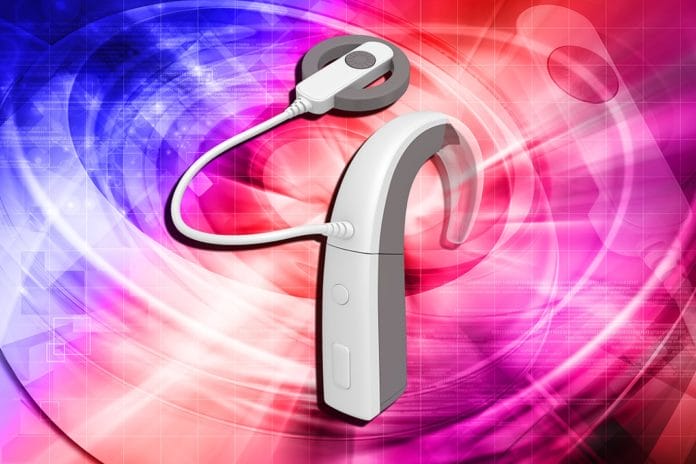The shortest journal I have ever kept arguably contains the most important observations of my life. After 60 years of deafness, I recently was the recipient of a cochlear implant. The related journal on my hard drive, though, only offers eight entries – from just eight days.
Don’t get me wrong. Cochlear implants are life-changing, complete with the frequent and fun discoveries about the sense of sound. I wrote about the noisiness of potato chips, for example, as well as the helicopter landing on top of my house. The latter was actually the clothes dryer, but it sure sounded like the house was being invaded. As I write this, I still have not gone to a laundromat. I may wait a while yet for that hearing experience.
I am wired in on my wife’s decisions in the morning on whether she wears her boots or other footwear. I can now tell the difference. It doesn’t matter about my shoes. Although I could randomly hear my footsteps before the cochlear implant, depending on the shoes worn or the type of floor surface, I can hear my footsteps all the time now.
In fact, that was an early pet peeve about the contemporary hearing correction of cochlear implants. I could also now hear my breathing 24/7. Although that was a nice experience too, I soon began wondering, “How do people with normal hearing tune out their footsteps and breathing?” I found out that it just happens. If I want to listen to my feet and breaths, I can. Most of the time, I relegate the noise to the background.
The “background” is a little different from what cochlear implant wearers refer to as the “wall of noise.” That wall prompted me to stop thinking about clever things to write in my journal. The wall of noise made me realize that there was no post-surgical miracle, just hard work waiting for me every single day. The wall of noise still makes certain experiences as difficult as they were before the surgery, such as going to a movie or a party, talking on the telephone, and, yes, going to the dentist’s office.
The Wall of Noise
The wall of noise is not necessarily background noise that needs to be shelved into a category of irrelevant sound. At first, the garage door opener and my wife’s voice sounded identical to me. The former is not relevant while the latter’s relevance is absolutely critical. Although we can make jokes here about husbands listening to wives, in my case there is no one that I communicate with more frequently on a daily basis than my wife. It doesn’t help if she sounds like the garage door is opening.
In the dental setting, the wall of noise consists of everything from cabinets being closed to dental professionals explaining the steps of treatment over the noise of equipment. The cochlear implant recipient struggles to make sense of what the wall of noise means.
(Angel Sounds, a software program developed for cochlear implant recipients, offers one section that trains users on environmental noises. A “dentist’s drill” is one of the noises captured in the program. Ask your patients with cochlear implants what they think. They may say the drill sounds “soft” and express confusion over why people with normal hearing shudder with apprehension at the dental noise. The dental handpiece really isn’t the most frightful noise out there.)
The deaf or hearing challenged lose their hearing to a variety of causes and at different stages in life. A cochlear implant wearer who retained normal hearing until after becoming an adult may adjust to the wall of noise more quickly. But they may also complain that human voices resemble “Mickey Mouse” or cartoonish. Some say the noise experienced does not quite capture what their memory tells them that they heard before a loss in hearing. On the other hand, a formerly deaf individual will possess no memories of sounds. Instead, a deaf person or someone with severe hearing loss struggles to make sense out of the wall of noise. But they are also accepting of the sounds transmitted by the processor, since they were unfamiliar with what it sounded like before surgery.
The cochlear implant is never presented by audiologists and ear, nose, and throat surgeons as a “cure” to deafness. They do, however, often present the cochlear implant as being a substantial upgrade to a hearing aid, a conclusion reached after diagnostic exams and X-rays. The implant is surgically placed, and the connection is electronically activated via magnets on the skull, as opposed to an ear mold inserted into the canal with a hearing aid.
Most dental professionals are accustomed to appointments with the hearing challenged. Face the patient and methodically ensure that communication is successful. While a hearing aid helps “level the playing field” for someone who has hearing loss, the cochlear implant restores hearing to levels as normal as technologically possible. The “Mickey Mouse” sounds of human conversation, for example, may soon become a thing of the past as the major manufacturers of cochlear implants continuously search for innovative solutions to challenges.
The wall of noise is immediate. Ask your patient with cochlear implant about the appointment that occurs after surgery. They refer to it as the “activation” appointment. The audiologist sets the processor worn over the ear for specific decibel levels and flips the switch, so to speak. The wall of noise completely envelopes the recipient, sometimes uncomfortably so. The audiologist will adjust the “mapping” for comfort and abilities to hear certain sound levels. The mapping sessions continue over several appointments as the audiologists adjust for maximum input and, wait for it …
The Sound of Rehabilitation
The electrical impulses interpreting sounds function much like a cochlea, or inner ear, does. But it’s not identical, and one body organ that struggles with those differences is the human brain. The brain is uncertain how to interpret most of the noises transmitted by the implant.
So the rehabilitation of the adult patient consists of “training the brain.” Recipients are, of course, encouraged to wear the processor as often as possible. Right after activation, they read aloud themselves, listen to others without lipreading, and become accustomed to other sounds at a “normal volume.”
Audiologists caution recipients that the rehabilitation process can last from six months to one year. So there could be one to two dental appointments during this process. The rehabilitation requires much patience and perseverance on the part of the recipient, and it is easy to feel frustrated at times over the months-long journey.
The National Institute on Deafness and Other Communication Disorders in 2017 projected that more than 300,000 implants have been placed internationally, with approximately 60,000 of them in the United States. The real joy of cochlear implants is that more than half have been successfully placed in children. With children, the learning curve is shortened as the implant becomes a normal part of their lives more quickly, and the social isolation associated with deafness is eliminated with many of these deaf or hearing challenged children.
Adults, though, have to patiently sort through their daily exercises, noticing the improvements in their hearing on an incremental basis. All noises are now loud noises. The daily assignments focus on what the sounds mean, or just what are they. Angel Sounds, for example, repetitively issues three sounds, and one sound is different from the other two. Although he or she does not know why a sound is different, the recipient eventually distinguishes between them and even identifies them, particularly that “soft” dental handpiece. In addition, female voices often initially sound masculine at first, but the female dentist, hygienist, or assistant will eventually sound more feminine.
On a recent day, I was cruising along at identifying 70 to 80 percent of sounds correctly, but the stumbles included not being able to tell the difference between “pool” and “pale” or “will” and “whirl.” The rehabilitation can be frustrating.
The “CI guy”
So how does the dental professional react to seeing the cochlear implant (CI) recipient on the schedule?
If it’s a long-term patient of record, then you already know that the appointment will likely be a pleasant one. The veteran CI wearer has completed rehabilitation, and they emphatically state that all of their work is “well worth it.” Communication should be a normal process, but they are not shy about asking the dental hygienist to repeat something while genuinely smiling at the wonderment of it all.
Part of the journey to where they are now is learning not to rely on lip reading. So dental professionals may feel a little disconcerted about the lack of eye contact with some CI patients. They should focus on the good news about the ease of talking with CI patients (even while wearing a mask) as opposed to sign language or patiently repeating information.
The new recipient of a cochlear implant, however, is an incomplete medical procedure sitting in your dental chair.
If the “activation” appointment has not yet occurred, the dental appointment may be more challenging than previous appointments where protocols were in place for the deafness or hearing loss. The patient now has worse hearing loss. Although some implant recipients retain some functions of the cochlea after surgery, most don’t. The patients usually understand the risk of losing whatever hearing they had during the surgery, but they are usually completely deaf in that ear until activation. The good news is that this occurs for just one dental appointment.
If a patient is 100% deaf in both ears, a rescheduling of the dental appointment until after activation may be necessary, particularly if the dental professional foresees the need to explain a complex diagnosis.
One oral side effect of cochlear implant surgery is jaw pain. The dental patient, who may not have yet attended the post-operative appointment with the surgeon, could complain that something is “now wrong with my TMJ.” The pain usually disappears during the weeks after the surgery but feel encouraged to follow up with the patient about the jaw pain at the next appointment.
If activation has occurred, remember that each CI wearer is at different stages of his or her journey. The “wall of noise” may still be a detrimental factor during communication. They may insist on communicating with a heavy reliance on lipreading and many statements by the dental professional may need to be repeated.
A dental professional can ask to be notified if a “new sound” is uncomfortable or frightening. But it may be better to wait for a visual cue that the patient is experiencing discomfort. In addition, some implant wearers complain of tinnitus, incorrectly blaming dental equipment for contributing to it. The dental professional may want to consider manual scaling, for example, over the ultrasonic scaler, and then wait to see if the symptoms for tinnitus present at the next appointment.
Cochlear implant wearers, though, are generally very curious about the sounds discovered in a different environment. A child or even adult dental patient with a CI may enjoy hearing a sound for the first time before its dental application. New noises are very interesting to someone who has no recollection of hearing the noise previously.
The dental patient with a cochlear implant knows that there are surprises with noises that people with normal hearing take for granted. They know it’s a challenge to “get used to it.” They may often wince at a new noise and then almost immediately accept it as normal.
However, patient comfort is an important part of any dental appointment. Until dental encounters between dental professionals and CI patients create a high level of familiarity, it is important to observe visual cues related to the sounds of dental treatment, as well as the effectiveness of patient education.
An added benefit to the cochlear implant experience is to discover what was missed before, and the cochlear implant patient can derive many benefits from an increased awareness of oral health. Take a moment during the seating process to ascertain where the cochlear implant patient is on his or her journey and allow them to enjoy the experience of really hearing the dental appointment, often for the first time.











